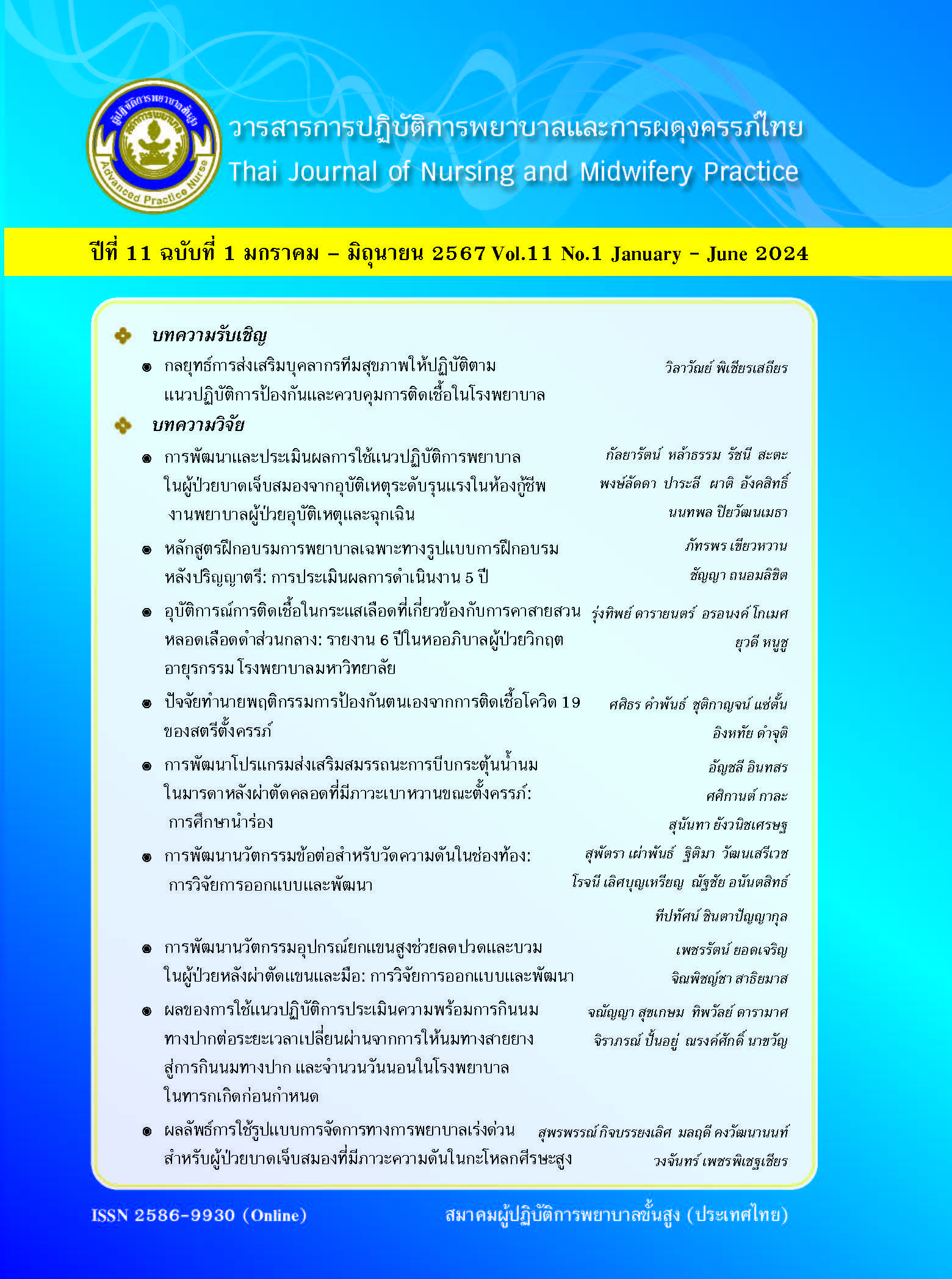Incidence of Central Line-Associated Bloodstream Infection: A 6-year Report in the Medical Intensive Care Unit at a University Hospital
Main Article Content
Abstract
Central line associated bloodstream infection (CLABSI) is a significant complication in critically ill patients undergoing catheter placement. This research was a retrospective study to determine the incidence of bloodstream infections associated with catheter placement in patients admitted to the medical intensive care unit from January 2017 - December 2022. A demographic data and diagnosis of CLABSI form was used for data collection. Data were analyzed using descriptive statistics. The results showed that there were 1868 patients with catheters; most were male. The most common catheter insertion position was a jugular vein. A total of 13 infections were found per 10,019 total catheter days. The lowest average number of catheter days was 4.6 days in 2019 and the highest 6.2 days in 2020. The highest infection rate was 1.51 times per 1,000 catheter days in 2017 and the lowest 0.63 times per 1,000 catheter days in 2022. The most common causative bacteria were gram-negative bacteria which are multidrug resistant, including Klebsiella pneumoniae and Acinetobacter baumannii. In conclusion, the incidence of infection tended to decrease continuously. Nurses should play a significant role to review the problem and search for practical preventive procedures, such as by increasing the scrub hub and using an antiseptic barrier cap, as well as by
monitoring and supervising practices.
Downloads
Article Details

This work is licensed under a Creative Commons Attribution-NonCommercial-NoDerivatives 4.0 International License.
References
Leistner R, Hirsemann E, Bloch A, et al. Costs and prolonged length of stay of central venous catheter–associated bloodstream infections (CVC BSI): A matched prospective cohort study. Infection. 2014; 42(1): 31-6. doi: 10.1007/s15010-013-0494-z.
Stevens V, Geiger K, Concannon C, et al. Inpatient costs, mortality and 30-day readmission in patients with central line-associated bloodstream infections. Clin Microbiol Infect. 2014; 20(5): O318-24. doi: 10.1111/1469-0691.12407.
Ziegler MJ, Pellegrini DC, Safdar N. Attributable mortality of central line associated bloodstream infection: systematic review and meta-analysis. Infection. 2015; 43(1): 29-36. doi: 10.1007/s15010-014-0689-y.
Alshahrani KM, Alhuwaishel AZ, Alangari NM, et al. Clinical Impacts and Risk Factors for Central Line-Associated Bloodstream Infection: A Systematic Review. Cureus. 2023; 15(6): e40954. doi: 10.7759/cureus.40954.
The Infection Control Unit. Report of patients with central venous catheters from 2017-2023 Songklanagarind Hospital. Songkla; 2023.
Marschall J, Mermel LA, Fakih MG, et al. Strategies to Prevent Central Line-Associated Bloodstream Infections in Acute Care Hospitals: 2014 Update. Infect Control Hosp Epidemiol. 2014; 35(7): 753-71. doi: 10.1086/676533.
Buetti N, Marschall J, Drees M, et al. Strategies to prevent central line-associated bloodstream infections in acute-care hospitals: 2022 Update. Infect Control Hosp Epidemiol. 2022; 43(5): 553-69. doi: 10.1017/ice.2022.87.
National Healthcare Safety Network. Bloodstream Infection Event (Central Line-Associated Bloodstream Infection and Non-central Line Associated Bloodstream Infection). 2016; 25-40.
Moureau NL, Flynn J. Disinfection of Needleless Connector Hubs: Clinical Evidence Systematic Review. Nurs Res Pract. 2015; 1-20. doi: 10.1155/2015/796762.
Devrim I, Demiray N, Oruç Y, et al. The colonization rate of needleless connector and the impact of disinfection for 15 s on colonization: A prospective pre-an post-intervention study. J Vasc Access. 2019; 20(6): 604-7. doi: 10.1177/1129729819826036.
The Medical Intensive Care Unit. Report: compliance with measures to reduce CLABSI infections in 2018 Songklanagarind Hospital. Songkla; 2018. Thai.
Voor In’t Holt AF, Helder OK, Vos MC, et al. Antiseptic barrier cap effective in reducing central line-associated bloodstream infections: A systematic review and meta-analysis. Int J Nurs Stud. 2017; 69: 34-40. doi: 10.1016/j.ijnurstu.2017.01.007.
Tejada S, Leal-dos-Santosc M, Pena-Lopez Y, et al. Antiseptic barrier caps in central line-associated bloodstream infections: A systematic review and meta-analysis. Eur J Intern Med. 2022; 99: 70-81. doi: 10.1016/j.ejim.2022.01.040.
Yingkhajorn S, Sutthichot S, Hongthong N, et al. Occurrence of Antimicrobial Resistance in Hospital: A Systematic Review and Meta-analysis. J Health Sci Thai. 2021; 30(5): 916-27. Thai.
Pornchaloempong P, Rattanapanon N. Gram negative bacteria [Internet]. [date unknown] [cited 2024 Feb 6]. Available from: https://www.foodnetworksolution.com/wiki/word/1542/gram-negativebacteria.


